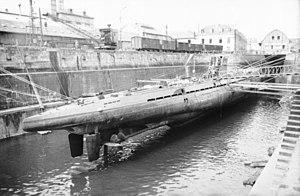|
German submarine U-41 (1939)
The German submarine U-41 was a Type IXA[1] U-boat of Nazi Germany's Kriegsmarine that operated during World War II. She conducted three war patrols during her short career, two as part of the 6th U-boat Flotilla and one as part of the 2nd flotilla. U-41 also sank five enemy vessels for a total of 22,815 gross register tons (GRT); captured two more for a total of 2,073 GRT and damaged one other of 8,096 GRT.[2] On 5 February 1940, U-41 was hit by depth charges from the British A class destroyer HMS Antelope after sinking two enemy merchant vessels and was sunk off the south coast of Ireland. All 49 of her crew members were lost with the boat. ConstructionU-41 was ordered by the Kriegsmarine on 21 November 1936 (as part of Plan Z and in violation of the Treaty of Versailles). She was laid down on 27 November 1937 by AG Weser, Bremen as yard number 946. She was launched on 28 January 1939 and commissioned on 22 April of that same year under the command of Oberleutnant zur See Gustav-Adolf Mugler.[2] DesignAs one of the eight original Type IX submarines, later designated IXA, U-41 had a displacement of 1,032 tonnes (1,016 long tons) when at the surface and 1,153 tonnes (1,135 long tons) while submerged.[3] The U-boat had a total length of 76.50 m (251 ft), a pressure hull length of 58.75 m (192 ft 9 in), a beam of 6.51 m (21 ft 4 in), a height of 9.40 m (30 ft 10 in), and a draught of 4.70 m (15 ft 5 in). The submarine was powered by two MAN M 9 V 40/46 supercharged four-stroke, nine-cylinder diesel engines producing a total of 4,400 metric horsepower (3,240 kW; 4,340 shp) for use while surfaced, two Siemens-Schuckert 2 GU 345/34 double-acting electric motors producing a total of 1,000 metric horsepower (740 kW; 990 shp) for use while submerged. She had two shafts and two 1.92 m (6 ft) propellers. The boat was capable of operating at depths of up to 230 metres (750 ft).[3] The submarine had a maximum surface speed of 18.2 knots (33.7 km/h; 20.9 mph) and a maximum submerged speed of 7.7 knots (14.3 km/h; 8.9 mph).[3] When submerged, the boat could operate for 65–78 nautical miles (120–144 km; 75–90 mi) at 4 knots (7.4 km/h; 4.6 mph); when surfaced, she could travel 10,500 nautical miles (19,400 km; 12,100 mi) at 10 knots (19 km/h; 12 mph). U-41 was fitted with six 53.3 cm (21 in) torpedo tubes (four fitted at the bow and two at the stern), 22 torpedoes, one 10.5 cm (4.13 in) SK C/32 naval gun, 180 rounds, and a 3.7 cm (1.5 in) SK C/30 as well as a 2 cm (0.79 in) C/30 anti-aircraft gun. The boat had a complement of forty-eight.[3] Service historyDuring her service in the Kriegsmarine, U-41 sank five commercial ships for 22,815 gross register tons (GRT); damaged one commercial vessel of 8,096 GRT and captured two ships totalling 2,073 GRT.[4] First patrolU-41 left Wilhelmshaven on 19 August 1939, before World War II began, with then Oblt. Gustav Adolf-Mugler in command. Her first patrol involved traveling as far south as Portugal after entering the North Sea and circumnavigating the British Isles. During this patrol, two ships were captured: the Finnish Vega, of 974 GRT, and the 1,099 GRT Suomen Poika. U-41 then returned to Wilhelmshaven, arriving on 17 September 1939.[5] Second patrolU-41 left Wilhelmshaven with Mugler in command once again on 7 November 1939. On 12 November, both the 275 GRT British vessel Cresswell and the 11,019 GRT Norwegian ship Arne Kjøde were sunk by torpedoes. The 1,351 GRT British merchant vessel Darino went to the bottom on the 19th. The last enemy vessel to be sunk by U-41 was the French vessel Les Barges II. She displaced a total of 296 GRT and was sunk by a single torpedo on 21 November. The U-boat then returned to port on 7 December 1939.[6] Third patrolU-41 left the port of Helgoland on 27 January 1940 with Mugler still in command. During her final patrol, one enemy ship was sunk and one was damaged; both of these attacks took place on 5 February. The first ship that was hit was the 8,096 GRT Dutch vessel Ceronia. The Ceronia was damaged and the 9,874 GRT British ship Beaverburn was sunk. Nevertheless, U-41 did not return to her home port, she was sunk on the same day.[7] FateFollowing the attacks on the Dutch Ceronia and the British Beaverburn on 5 February 1940, U-41 was attacked by the British A class destroyer HMS Antelope with depth charges. She was hit and sunk off the south coast of Ireland. All 49 of her crew members were lost with the boat during the attack.[2][7][8] Summary of raiding history
References
Bibliography
External links
|
|||||||||||||||||||||||||||||||||||||||||||||||||||||||||||||||||||||||||||||||||||||||||||||||||||||||||||
